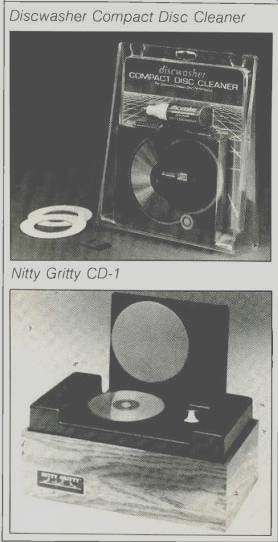FINGERING PRINTS

When Compact Discs were introduced, a lot of tales were told about how impervious they were to scratches, dirt, and other artifacts which have always been very destructive to vinyl records. There even was a story that peanut butter could be spread on a CD, and after it was cleaned off, the disc could be played without difficulty. Unfortunately, the CD is a victim of its own propaganda, which, coupled with the "no wear" factor, has lulled people into thinking that it is nearly indestructible. Even though consumers have been generally admonished to hold a CD by its edges and treat it with the same respect accorded vinyl discs, the small size of the CD, its ease of handling, and the early fanciful tales about its total immunity to contamination have made people careless. As a consequence, myriad fingerprints, dust, and assorted detritus must be dealt with.
Last issue, in my discussion of CD error correction, I pointed out that a minor interruption of the music, or a momentary or cyclic noise, may some times be amenable to simple cleaning.
The most basic form of CD cleaning is to breathe on the disc and then use a tissue or soft cloth to wipe the condensate from center to edge, as if following the spokes of a wheel. A more thorough job of cleaning can be accomplished by wiping the CD--always with radial strokes--with ethyl alcohol.
The most readily available household source of this is from a bottle of 100-proof vodka, which is equivalent to 50% ethyl alcohol.
There are various commercial CD cleaning fluids which one hopes will do their job without leaving an invisible and potentially bothersome residue.
There are also a number of CD cleaning devices which rotate the disc, but most of them use a circular cleaning motion and not the preferred radial strokes.
One device which works properly is the Discwasher Compact Disc Cleaner. A plastic case contains a circular CD platform with gear teeth around its circumference. A cleaning wheel, also with gear teeth, is mounted in the plastic cover of the case and is fitted with a soft, absorbent cleaning pad. An inter mediate drive gear is between the CD platform and the cleaning wheel. The cleaning wheel is mounted eccentrically, and, when it is rotated by a small crank handle, a radial motion is imparted to the pad. The cleaning procedure involves spraying the CD with the sup plied cleaning fluid, placing the treated CD on the platform, closing the plastic cover, and rotating the cleaning pad in either direction for about 20 revolutions. The action is a bit stiff from the gearing and 20 turns are a little tedious, but the Discwasher system does clean CDs effectively. The cleaning kit with case, fluid, and replacement cleaning pad is $19.95. Of course, refills of the CD-1 fluid and cleaning pads are available.
Of all the contaminants a CD can be subject to, the most common--and the most bothersome--are fingerprints.
Now, there are different kinds of finger prints, and perhaps they should be rated on a "gloppiness index." For example, there is the common, garden-variety fingerprint from normal, clean fingers; the error-correction capabilities of most CD players can cope with these quite nicely. If your fingers are a bit moist or clammy, correction be comes a bit more difficult. If you have an oily complexion and rub your nose or forehead with your fingers and subsequently put a print on a CD, this can stop the error-correction systems of a fair number of CD players dead in their tracks.
The worst-case scenario for finger prints, those with the highest rating in the "gloppiness index," would involve food. Say you're at a picnic, where your fingers can be loaded with grease from that cold fried chicken or similar foods, and you happen to have a portable CD player to entertain you in your sylvan glade. Or you are at a drive-in burger palace, and after your double decker cheeseburger and fries, you play some CDs on your car CD player.
Picnic or burger stop, you are unlikely to do more than wipe your fingers with a paper napkin or towel. This virtually guarantees your fingers will have a heavy film of oil. If you happen to put some prints on your CD, all but the most sophisticated error-correction systems of the top players will be over whelmed, and the machine will simply not play the CD.
I did some experiments in which I put fingerprints of various degrees of "gloppiness" on some CD surfaces. To simulate the picnic/burger-stop situation, I dipped a finger into bacon fat, then wiped it with a paper napkin. I placed some prints very close to the center hole, on the midsection, and on the periphery of a CD. I tried playing this heavily fingerprinted disc on a variety of players, including some of the most highly regarded and expensive units on the market. None of the sever al players I tried could cope with this kind of heavy, oily fingerprint. In some cases it was almost comical: When the CD was placed in the motorized drawer and the machine was started, the disc would be pulled into the machine and then promptly rejected, and the drawer would open to the loading position. This was generally the case when a fingerprint was placed close to the center hole. With a CD on which placed prints only at the middle and outer sections, the best players would start properly; then, as the lasers en countered the first outer whorls and ridges of the fingerprints, they would struggle valiantly to correct the errors making noises and exhibiting increasingly bad mistracking, and then stop completely.

above: Discwasher Compact Disc Cleaner; Nitty Gritty CD-1
The Nitty Gritty Company, which makes excellent cleaning machines for vinyl records, has come up with a CD-cleaning machine that is, in my opinion, unquestionably the easiest to use as well as the most efficient and effective method of ensuring pristine CD playing surfaces. The Nitty Gritty CD-1 Compact Disc cleaner measures 12 3/4 in. x 7 in. x 5 3/4 in.; its base is covered in wood-grained vinyl, and its hinged top is plastic. The lid's under side has a circular, stationary, foam-rubber platform with a soft and replaceable cleaning pad made of cloth-like material. A motorized CD turntable is mounted eccentrically so that it rotates about two different centers simultaneously. This causes the cleaning path to be almost perpendicular to the CD's signal track. Next to the turntable is a storage well for the Pure CD cleaning fluid, and the on/off switch.
The Pure fluid, which is really more like an emulsion, is spread in a thin line across the diameter of the CD by using the cloth applicator tip of its squeeze bottle. The treated CD is placed on the turntable, the lid with the cleaning pad lowered onto the disc, and the motor switched on for 30 to 60 seconds. The eccentric scrubbing action completely cleans the CD, buffing it to a brilliant, highly reflective shine, and renders the CD free of static. The Pure CD cleaner is also said to leave a protective layer that resists scratches. I had no way of verifying this claim, but I can say that the Nitty Gritty CD cleaner most effectively removed my worst bacon-grease fingerprints from test CDs; they all played flawlessly.
The amount of Pure CD cleaner used per disc is very little, and the two-ounce bottle should clean about 100 discs. The Nitty Gritty Compact Disc cleaning machine retails at $159, including fluid and several cleaning pads. Refills of the Pure CD fluid are $5.95, and replacement cleaning pads are also available.
It doesn't take long to build up quite an investment in a collection of CDs.
For many people, maintaining them in top playing condition will justify the price of this Nitty Gritty cleaner. Of course, you can obviate all the bother and expense by simply keeping your cotton-pickin' fingers off your CD surfaces!
(adapted from Audio magazine, Aug. 1986; Bert Whyte)
= = = =